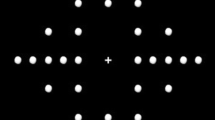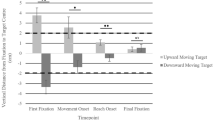Abstract
Many movements that people perform every day are directed at visual targets, e.g., when we press an elevator button. However, many other movements are not target-directed, but are based on allocentric (object-centered) visual information. Examples of allocentric movements are gesture imitation, drawing or copying. Here, show a reaction time difference between these two types of movements in four separate experiments. In Exp. 1, subjects moved their eyes freely and used direct hand movements. In Exp. 2, subjects moved their eyes freely and their movements were tool-mediated (computer mouse). In Exp. 3, subjects fixated a central target and the visual field in which visual information was presented was manipulated. Experiment 4 was identical to Exp. 3 except for the fact that visual information about targets disappeared before movement onset. In all four experiments, reaction times in the allocentric task were approximately 35 ms slower than they were in the target-directed task. We suggest that this difference in reaction time between the two tasks reflects the fact that allocentric, but not target-directed, movements recruit the ventral stream, in particular lateral occipital cortex, which increases processing time. We also observed an advantage for movements made in the lower visual field as measured by movement variability, whether or not those movements were allocentric or target-directed. This latter result, we argue, reflects the role of the dorsal visual stream in the online control of movements in both kinds of tasks.




Similar content being viewed by others
References
Bock O (1986) Contribution of retinal versus extraretinal signals towards visual localization in goal-directed movements. Exp Brain Res 64(3):476–482
Brown LE, Rosenbaum DA, Sainburg RL (2003) Limb position drift: implications for control of posture and movement. J Neurophys 90:3105–3118
Cohen NR, Cross ES, Tunik E, Grafton ST, Culham JC (2009) Ventral and dorsal stream contributions to the online control of immediate and delayed grasping: a TMS approach. Neuropsychologia 47:1553–1562
Danckert J, Goodale MA (2003) The ups and downs of vision. In: Johnson SH (ed) From intentions to movements. MIT Press, Cambridge, pp 29–64
de Grave DDJ, Brenner E, Smeets JBJ (2004) Illusions as a tool to study the coding of pointing movements. Exp Brain Res 155:56–62
Desmurget M, Pelisson D, Rossetti Y, Prablanc C (1998) From eye to hand: planning goal-directed movements. Neurosci Biobehavioral Rev 22:761–788
Desmurget M, Epstein CM, Turner RS, Prablanc C, Alexander GE, Grafton ST (1999) Role of the posterior parietal cortex in updating reaching movements to a visual target. Nat Neurosci 2:563–567
DiZio P, Lackner JR (1995) Motor adaptation to coriolis force perturbations of reaching movements: endpoint but not trajectory adaptation transfers to the nonexposed arm. J Neurophys 74:1787–1792
Filimon F, Nelson JD, Huang RS, Sereno MI (2009) Multiple parietal reach regions in humans: cortical representations for visual and proprioceptive feedback during on-line reaching. J Neurosci 29:2961–2971
Ghez C, Scheidt R, Heijink H (2007) Different learned coordinate frames for planning trajectories and final positions in reaching. J Neurophys 98:3614–3626
Gottlieb GL (1996) On the voluntary movement of compliant (inertialviscoelastic) loads by parcellated control mechanisms. J Neurophys 76:3207–3229
Gréa H, Pisella L, Rossetti Y, Desmurget M, Tilikete C, Grafton S, Prablanc C, Vighetto A (2002) A lesion of the posterior parietal cortex disrupts on-line adjustments during aiming movements. Neuropsychologia 40(13):2471–2480
Haggard P, Newman C, Blundell J, Andrew H (2000) The perceived position of the hand in space. Percept Psychophys 62(2):363–377
Henriques DYP, Klier EM, Smith MA, Lowey D, Crawford JD (1998) Gaze-centered re-mapping of remembered visual space in an open-loop pointing task. J Neurosci 18:1583–1594
Hirayama M, Kawato M, Jordan MI (1993) The cascade neural network model and a speed-accuracy trade-off of arm movement. J Motor Behavior 25:162–174
Izawa J, Shadmehr R (2008) Online processing of uncertain information in visuomotor control. J Neurosci 28:11360–11368
Lackner JR, DiZio P (1994) Rapid adaptation to coriolis force perturbations of arm trajectory. J Neurophys 72:299–313
Lackner JR, DiZio P (1998) Gravito inertial force background level affects adaptation to coriolis force perturbations of reaching movements. J Neurophys 80:546–553
Liu D, Todorov E (2007) Evidence for the flexible sensorimotor strategies predicted by optimal feedback control. J Neurosci 27:9354–9368
Loftus A, Servos P, Goodale MA, Mendarozqueta N, Mon-Williams M (2004) When two eyes are better than one in prehension: monocular viewing and end-point variance. Exp Brain Res 158(3):317–327
Milner AD, Goodale MA (2008) Two visual systems re-viewed. Neuropsychologia 46(3):774–785
Milner AD, Paulignan Y, Dijkerman HC, Michel F, Jeannerod M (1999) A paradoxical improvement of optic ataxia with delay: new evidence for two separate neural systems for visual localization. Proc R Soc Lond B 266:2225–2230
Milner AD, Dijkerman HC, Pisella L, McIntosh RD, Tilikete C, Vighetto A, Rossetti Y (2001) Grasping the past: delay can improve visuomotor performance. Curr Biol 11:1896–1901
Milner AD, Dijkerman HC, McIntosh RD, Rossetti Y, Pisella L (2003) Delayed reaching and grasping in patients with optic ataxia. Prog Brain Res 142:225–242
Ogawa K, Inui T, Sugio T (2006) Separating brain regions involved in internally guided and visual feedback control of moving effectors: an event-related fMRI study. Neuroimage 32(4):1760–1770
Pisella L, Gréa H, Tilikete C, Vighetto A, Desmurget M, Rode G, Boisson D, Rossetti Y (2000) An ‘automatic pilot’ for the hand in human posterior parietal cortex: toward reinterpreting optic ataxia. Nat Neurosci 3:729–736
Previc FH (1990) Functional specialisation in the lower and upper visual fields in humans: its ecological origins and neurophysiological implications. Behav Brain Sci 13:519–575
Sainburg RL, Wang J (2002) Interlimb transfer of visuomotor rotations: Independence of direction and final position information. Exp Brain Res 145:437–447
Sainburg RL, Ghez C, Kalakanis D (1999) Intersegmental dynamics are controlled by sequential anticipatory, error correction, and postural mechanisms. J Neurophys 81:1040–1056
Scheidt RA, Ghez C (2007) Separate adaptive mechanisms for controlling trajectory and final position in reaching. J Neurophys 98:3600–3613
Schenk T (2006) An allocentric rather than perceptual deficit in patient D.F. Nat Neurosci 9:1369–1370
Schlicht E, Schrater P (2007) Impact of coordinate transformation uncertainty on human sensorimotor control. J Neurophys 97:4203–4214
Strother L, Aldcroft A, Lavell C, Vilis T (2010) Equal degrees of object-selectivity for upper and lower visual field stimuli. J Neurophys 104(4):2075–2081
Thaler L, Goodale MA (2010) Beyond distance and direction: the CNS represents target location in a non-metric format. J Vis 10(3):1–27
Thaler L, Goodale MA (2011) The role of online visual feedback for the control of target-directed and allocentric hand movements. J Neurophys 105:846–859
Thaler L, Todd JT (2009a) The use of head/eye-centered, hand-centered and allocentric representations for visually guided hand movements and perceptual judgments. Neuropsychologia 47:1227–1244
Thaler L, Todd JT (2009b) The control parameters used by the CNS to guide the hand depend on the visuo-motor task: evidence from visually guided pointing. Neurosci 159:578–598
Thaler L, Todd JT (2010) Evidence from visuomotor adaptation for two partially independent visuomotor systems. J Exp Psychol Hum Percept Perform 36(4):924–935
Acknowledgments
This work was supported by the Natural Sciences and Engineering Research Council of Canada (MAG) and a Postdoctoral Fellowship of the Ministry of Research and Innovation (Ontario) (LT). We thank two anonymous reviewers for their comments.
Author information
Authors and Affiliations
Corresponding author
Rights and permissions
About this article
Cite this article
Thaler, L., Goodale, M.A. Reaction times for allocentric movements are 35 ms slower than reaction times for target-directed movements. Exp Brain Res 211, 313–328 (2011). https://doi.org/10.1007/s00221-011-2691-2
Received:
Accepted:
Published:
Issue Date:
DOI: https://doi.org/10.1007/s00221-011-2691-2




